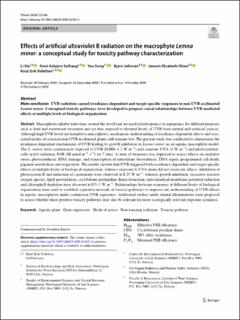| dc.description.abstract | Macrophytes inhabit waterways around the world and are used in hydroponics or aquaponics for different purposes such as feed and wastewater treatment and are thus exposed to elevated levels of UVB from natural and artificial sources. Although high UVB levels are harmful to macrophytes, mechanistic understanding of irradiance-dependent effects and associated modes of action in non-UVB acclimated plants still remains low. The present study was conducted to characterise the irradiance-dependent mechanisms of UVB leading to growth inhibition in Lemna minor as an aquatic macrophyte model. The L. minor were continuously exposed to UVB (0.008–4.2 W m−2) and constant UVA (4 W m−2) and photosynthetically active radiation, PAR (80 µmol m−2 s−1) for 7 days. A suite of bioassays was deployed to assess effects on oxidative stress, photosynthesis, DNA damage, and transcription of antioxidant biosynthesis, DNA repair, programmed cell death, pigment metabolism and respiration. The results showed that UVB triggered both irradiance-dependent and target-specific effects at multiple levels of biological organization, whereas exposure to UVA alone did not cause any effects. Inhibition of photosystem II and induction of carotenoids were observed at 0.23 W m−2, whereas growth inhibition, excessive reactive oxygen species, lipid peroxidation, cyclobutane pyrimidine dimer formation, mitochondrial membrane potential reduction and chlorophyll depletion were observed at 0.5–1 W m−2. Relationships between responses at different levels of biological organization were used to establish a putative network of toxicity pathways to improve our understanding of UVB effects in aquatic macrophytes under continuous UVB exposures. Additional studies under natural illuminations were proposed to assess whether these putative toxicity pathways may also be relevant for more ecologically relevant exposure scenarios. | en_US |

